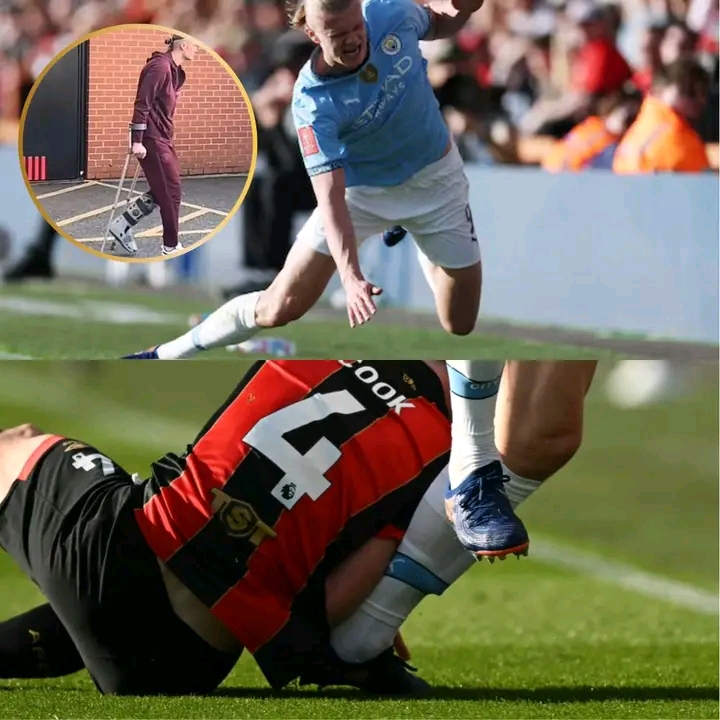Sport
“His Career Is in Jeopardy!” – Erling Haaland Seeks Specialist for Lingering Ankle Injury Amid Footballers’ Ongoing Battle with Ankle Issues

Manchester City and Norwegian football sensation Erling Haaland has raised concerns among fans and medical professionals alike as he seeks specialist consultation for a persistent ankle injury. The 24-year-old striker initially sustained the injury during Manchester City’s FA Cup quarter-final clash against Bournemouth, when his left foot became trapped under a challenge from Bournemouth midfielder Lewis Cook.
Despite visibly wincing in pain during the match, Haaland demonstrated his trademark resilience by continuing to play and even scoring City’s equalizing goal. However, his determination to play through the injury may have come at a cost, as club medical staff eventually substituted him due to increasing discomfort. Initial tests conducted by Manchester City’s medical team have proven inconclusive, prompting the need for specialized external evaluation.
The situation has sparked serious concerns within the football community, particularly given Haaland’s importance to both club and country. Manchester City manager Pep Guardiola addressed reporters briefly, stating, “We’re taking all necessary precautions with Erling’s recovery. His long-term health is our priority.” This cautious approach suggests the injury may be more complex than initially thought.
Medical experts familiar with football injuries have outlined several potential scenarios. Dr. Sarah Thompson, a sports medicine specialist at London’s Institute of Sport Medicine, explains: “Ankle injuries in footballers often involve multiple structures – ligaments, tendons, and sometimes bones. The fact Haaland continued playing after the initial trauma could have exacerbated the damage.”
Haaland’s case highlights a growing concern in professional football – the increasing frequency of ankle injuries among elite players. Data from the Premier League’s injury audit reveals that ankle problems account for nearly 18% of all injuries sustained by players, with forwards being particularly vulnerable due to the nature of their explosive movements and frequent contact situations.
The specific nature of Haaland’s injury remains undisclosed, but specialists will likely focus on several key areas. Primary concerns include potential damage to the anterior talofibular ligament (ATFL), the most commonly injured ankle ligament in football, as well as possible stress reactions in the talus or fibula bones. Advanced imaging techniques like MRI and possibly CT scans will be crucial for accurate diagnosis.
Complicating matters is Haaland’s unique physical profile. Standing at 6’4″ and weighing approximately 195 pounds, his combination of size, speed, and power places extraordinary demands on his joints. Sports biomechanist Dr. James Wilson notes: “Players of Haaland’s stature generate tremendous forces during acceleration and deceleration. Their ankles absorb impacts equivalent to several times their body weight with every change of direction.”
This isn’t Haaland’s first encounter with ankle troubles. During his time at Borussia Dortmund, he missed several matches due to similar issues, raising questions about whether this represents an acute injury or the flare-up of a chronic condition. Some medical professionals speculate that repeated microtrauma over years of high-intensity play may have weakened the joint’s structural integrity.
The timing couldn’t be worse for Manchester City. With crucial Premier League matches, the Champions League knockout stages, and the upcoming FIFA Club World Cup, the club faces a delicate balancing act between short-term competitive needs and protecting their star asset. Early estimates suggest Haaland could be sidelined for anywhere between two weeks to two months, depending on the diagnosis.
Haaland’s situation reflects a broader trend in modern football. The game’s increasing physical demands, coupled with packed match schedules, have led to rising injury rates. A recent UEFA study found that players participating in multiple competitions are 37% more likely to suffer musculoskeletal injuries than those with lighter workloads.
Treatment options will depend on the specialist’s findings. For minor ligament damage, conservative management with rest, physiotherapy, and gradual rehabilitation may suffice. More severe cases could require innovative interventions like platelet-rich plasma (PRP) therapy or even surgical stabilization in worst-case scenarios.
The psychological impact shouldn’t be underestimated either. Sports psychologist Dr. Emma Richardson explains: “For elite competitors like Haaland, forced inactivity can be mentally taxing. There’s often pressure to return prematurely, which can lead to compensatory movement patterns and secondary injuries.”
Manchester City’s medical team will likely implement a comprehensive recovery plan incorporating cutting-edge technologies like anti-gravity treadmills, hydrotherapy, and neuromuscular retraining. The club’s substantial investment in sports science infrastructure gives Haaland access to some of football’s most advanced rehabilitation resources.
As the football world awaits updates on Haaland’s condition, his situation serves as a stark reminder of the physical toll elite football exacts on players’ bodies. Whether this proves to be a minor setback or develops into a more serious concern may significantly influence both Manchester City’s season and Haaland’s burgeoning career trajectory.
The coming days will be critical as specialists work to determine the full extent of the damage and chart an appropriate recovery course. For now, fans worldwide hold their breath, hoping football’s most prolific young striker can overcome this latest challenge and return to his devastating best.

 Sport11 months ago
Sport11 months ago“I’m not trying to criticize Ancelotti, but I’m not happy with him for benching that player”: Bellingham Expresses Frustration Over Ancelotti’s Tactical Decision

 Sport11 months ago
Sport11 months agoBREAKING: Manchester City vs Liverpool Clash Cancelled! Title Race Takes a Twist

 Sport11 months ago
Sport11 months agoArsenal Poised for January Swoop on €70 Million Star Dusan Vlahovic

 Sport11 months ago
Sport11 months agoWHAT ON GOD’S GREEN EARTH DID WE JUST SEE?!

 Sport11 months ago
Sport11 months agoReal Madrid: Carlo Ancelotti’s Surprising Revelations About an Unexpected Quality of Vinicius

 Sport11 months ago
Sport11 months agoBREAKING: Arsenal’s Champions League Quarterfinal Opponent Revealed After Monaco’s Dramatic Win – Tough Challenges Await Arteta’s Men

 Sport11 months ago
Sport11 months agoChelsea Players Facing Suspension as Yellow Cards Mount

 Sport11 months ago
Sport11 months agoKey Arsenal Player Set for Return as Gunners Face Struggling Everton
















